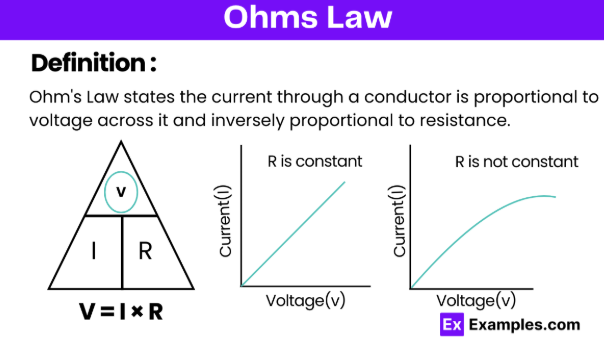Ohms law is one of the most important rules in electricity. Ohms law helps us understand how electricity moves in wires and devices. It tells us the relationship between voltage, current, and resistance. Voltage is the push that moves electricity, current is the flow of electricity, and resistance is what slows the electricity down. By using ohms law, we can calculate one of these values if we know the other two. This law is not just for students or engineers; it is very helpful for anyone who works with electronics, circuits, or even home appliances. Many devices like bulbs, fans, and computers work safely because ohms law is applied during their design. Learning ohms law makes electricity easier to understand and safer to use. Even simple circuits at home can be understood better with this basic rule.
Understanding ohms law is easier than it seems. Ohms law says that voltage equals current times resistance. This simple formula, written as V = I × R, can solve many problems in electronics. For example, if you know the voltage in a battery and the resistance of a device, you can find out how much current will flow. Ohms law also helps in designing circuits, choosing the right wire, or avoiding electrical problems. Many electronic devices and machines follow ohms law to work efficiently. Even beginners can use it to make small projects or experiments safely. Learning ohms law step by step, using examples, and practicing calculations makes it very easy. Once you understand it, you can predict how electricity will behave in almost any circuit.
Table of Contents
What is Ohms Law and Why It Matters
Ohms law is a basic rule in electronics. It shows how voltage, current, and resistance are related. Voltage is the energy that pushes electrons in a wire, current is the flow of electrons, and resistance is what makes it harder for the electrons to flow. Ohms law helps us know the right amount of electricity for devices. If a circuit has too much current, it can damage devices or wires. By using ohms law, we can design circuits safely. It also helps us understand why some bulbs burn out or wires get hot. Ohms law is a tool that everyone should know if they want to work with electricity safely.
How Ohms Law Works: Simple Explanation
Ohms law works like a simple math problem. The formula is V = I × R, where V is voltage, I is current, and R is resistance. For example, if a battery gives 9 volts and a bulb has 3 ohms of resistance, the current will be 3 amps. You can also find voltage or resistance if you know the other two. This makes ohms law very useful for testing circuits. You can predict how electricity will flow and prevent problems. It also makes learning electronics easier because you have a simple rule to follow for almost every circuit.
V = I × R: Breaking Down Ohms Law Formula
The formula V = I × R is simple but powerful.
- V (Voltage) is like the push of water in a pipe.
- I (Current) is like the flow of water in the pipe.
- R (Resistance) is like the size of the pipe or something blocking the water.
Using this formula, you can calculate electricity in any device. For example, if you know the current and resistance, you can calculate voltage: V = I × R. If you know voltage and resistance, you can find current: I = V ÷ R. And if you know voltage and current, you can find resistance: R = V ÷ I.
Real-Life Examples of Ohms Law in Everyday Life
Ohms law is not only for science labs. It is used in our daily life.
- In homes, it helps electricians choose the right wire size.
- In devices like phones and computers, it ensures safe electricity flow.
- Car batteries and circuits also use ohms law to work safely.
Even if you are just learning, you can see ohms law at work. For example, a small LED light needs less current than a big bulb. Using ohms law, you can calculate the right resistor to make it work safely.
Ohms Law in Simple Circuits for Beginners
Beginners can start with small circuits using batteries, bulbs, and wires. Use ohms law to calculate how much current will flow. For example, a 6-volt battery and a 2-ohm resistor will have 3 amps of current. Start with simple projects, like lighting a small bulb or making a buzzer sound. Using ohms law will help you understand how electricity moves in the circuit. It also prevents mistakes that can burn wires or damage components.
How to Calculate Voltage Using Ohms Law
Voltage can be calculated using V = I × R. For example, if a circuit has 2 amps of current and a resistance of 5 ohms, the voltage is 10 volts. This is helpful when designing circuits or checking batteries. By knowing voltage, you can ensure devices work safely and efficiently.
Finding Current with Ohms Law: Easy Steps
Current is the flow of electricity. To find current, use I = V ÷ R. For example, if a 12-volt battery is connected to a 4-ohm resistor, the current is 3 amps. Knowing current helps prevent overloading wires and devices. Beginners can measure current using a multimeter and check if their circuit is safe.
Understanding Resistance with Ohms Law
Resistance is how much a material slows down electricity. To find resistance, use R = V ÷ I. For example, if a device uses 6 volts and 2 amps, the resistance is 3 ohms. Different materials have different resistance. Metals like copper have low resistance, while rubber has high resistance. Understanding resistance helps in choosing the right wires and components for a circuit.
Common Mistakes People Make with Ohms Law
Many beginners make mistakes with ohms law:
- Mixing units like volts, amps, and ohms incorrectly.
- Using wrong resistance values in circuits.
- Forgetting to check battery voltage.
These mistakes can cause bulbs to burn, wires to heat up, or devices to break. Using ohms law carefully can prevent these problems. Always double-check your calculations before connecting a circuit.
Why Ohms Law is Important for Electronics Safety
Ohms law keeps circuits safe. Too much current can heat wires and cause fires. Too low resistance can damage devices. By calculating voltage, current, and resistance correctly, you can prevent accidents. Even small projects for beginners are safer with ohms law. It is also important for electricians, engineers, and hobbyists who work with electronics.
Fun Experiments to Learn Ohms Law at Home
You can try simple experiments:
- Connect a battery to a bulb using different resistors.
- Measure voltage and current with a multimeter.
- See how changing resistance affects brightness of the bulb.
These experiments make learning ohms law fun and practical. You can see how voltage, current, and resistance interact in real life.
Tips for Using Ohms Law in Projects and Repairs
- Always check voltage and resistance before connecting devices.
- Use the right resistor for LEDs and bulbs.
- Measure current to prevent overloading circuits.
- Practice calculations to get familiar with formulas.
Using these tips, beginners and experts can work safely with electronics. Ohms law is not only theory; it is practical and useful every day.
Conclusion
Ohms law is a simple but powerful rule in electricity. It helps us understand voltage, current, and resistance in circuits. By using ohms law, we can calculate one value if we know the other two. This makes circuits safer, devices work better, and learning electronics easier. Whether you are a student, hobbyist, or professional, ohms law is an essential tool. By practicing calculations and experiments, anyone can understand and use ohms law in daily life.
FAQs
Q1: What is the main formula of ohms law?
A1: The main formula is V = I × R, where V is voltage, I is current, and R is resistance.
Q2: Can ohms law be used for all circuits?
A2: Ohms law works for most simple circuits with constant resistance. It may not apply directly to complex or non-linear components.
Q3: How do I measure current in a circuit?
A3: Use a multimeter set to current mode and connect it in series with the circuit.
Q4: Why is ohms law important?
A4: It helps us calculate voltage, current, and resistance to make circuits safe and efficient.
Q5: Can beginners use ohms law?
A5: Yes! Beginners can use it for small experiments, home projects, and learning electronics safely.





